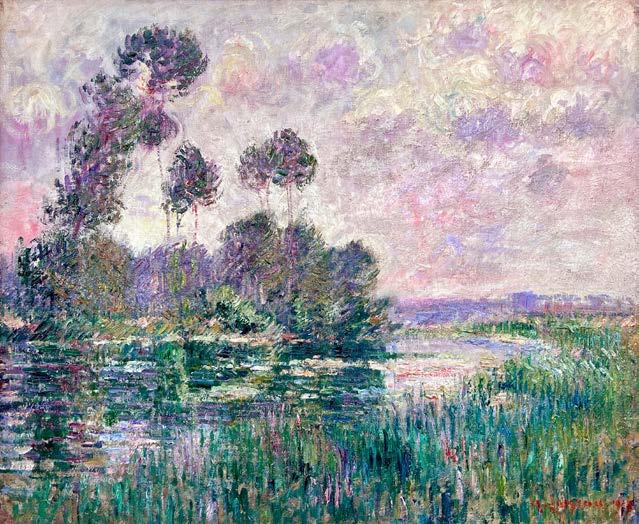
2 minute read
Gustave Loiseau
French, (1865-1935)
Peupliers sur les bords de l’Yonne reveals the masterful treatment of one of Loiseau’s most emblematic subjects: poplars by a riverside. In his focus upon poplars as a subject, Loiseau pays homage to the landscapes of Alfred Sisley and Claude Monet; most notably the latter is series of twenty-four views of poplars on the bank of the Epte in the spring of 1891.
The evocative composition of Peupliers sur les bords de l’Yonne depicts a bright summers day on the banks of the Yonne. The current work is a rare example of one of the few river scenes that the artist produced outside of Auxerre in 1907, and stands as a wonderful evocation of the French countryside at the pinnacle of Loiseau’s Impressionist manner.
Painted upstream from Auxerre, Peupliers sur les bords de l’Yonne is devoid of any human figures; Loiseau instead focuses on the fleeting light effects and gentle calm of the flowing river. The dappled reflections on the surface of the water are beautifully rendered in loose brushstrokes of thickly applied impasto oil paint. The layered impasto creates a distinction between land, water and sky as well as recreating the texture of the grasses, trees, and houses on the opposite bank. The painting resonates with the atmospheric quality of a warm summers day with a light breeze. The broad expanse of the river Yonne in the foreground delights the senses as Loiseau superbly captures the rippling effect of a warm breeze blowing across the surface of the water. This still and serene landscape is animated by the movement of the clouds in the sky, painted with longer, loose brushstrokes than their reflections in the water below, evoking a calming ambiance. Loiseau masterly depicted the clouded sky and abundant foliage with the use of delicate feathered brushstrokes, reminiscent of Monet’s technique.
Peupliers sur les bords de l’Yonne reveals the masterful treatment of one of Loiseau’s most emblematic subjects: poplars by a riverside. With their strict linearity and intrinsic decorative elegance, poplar trees were a favoured artistic motif in the late nineteenth and early twentieth century. Their slender height is often the only vertical compositional feature to be found in rural imagery, meaning that they tend to represent the best way to balance the strong horizontals typically found in riverscapes.
The painting’s rich surface, composed using spontaneous brushwork and areas of thickly applied paint, exemplifies Loiseau’s experimental nature. This still and serene landscape is animated by the movement of the gently rolling clouds in the sky, painted with loose, featherlike brushstrokes. Transient images of foliage dotted on the riverbank are captured in spontaneous, almost brushed strokes in a pointillist manner.Loiseau's technique and the chromatic variety of his palette express an extraordinary ability to synthesise Impressionism and Post-Impressionism.
Rivière en Normandie
Painted in 1913
Signed ‘G Loiseau 1913’ (lower right)
Oil on Canvas
54 x 65 cms / 21½" x 25¾"
Gustave Loiseau
French, (1865-1935)
Provenance
Galerie Félix Vercel, Paris.
Private Collection, Paris; acquired from the above.
Private Collection, by descent from the above.
Sale; Artcurial, Paris, 4th December 2012, lot 65.
Private Collection, acquired at the above sale.
Sale; Sotheby’s, London, 1st Mar 2018, lot 367.
Private Collection, UK; acquired from the above.
The authenticity of this work has been confirmed by Didier Imbert and this work is issued with a certificate of authenticity dated 2012.









